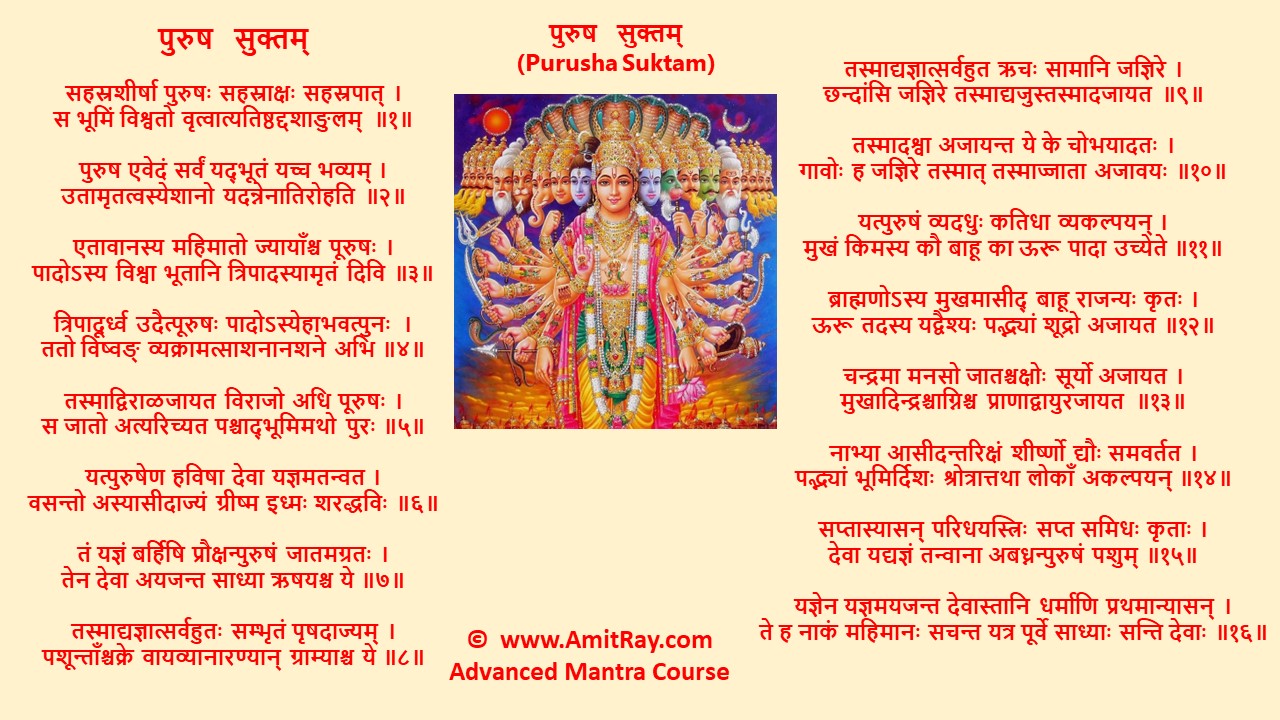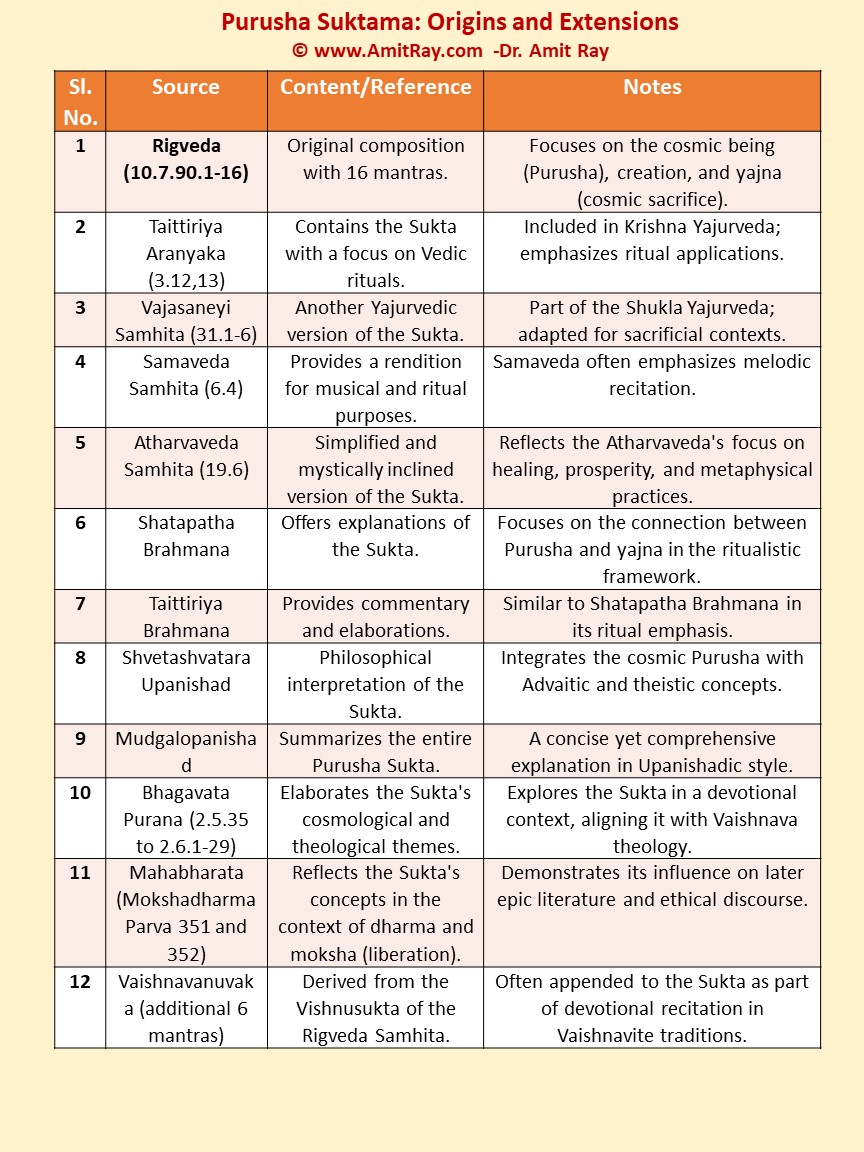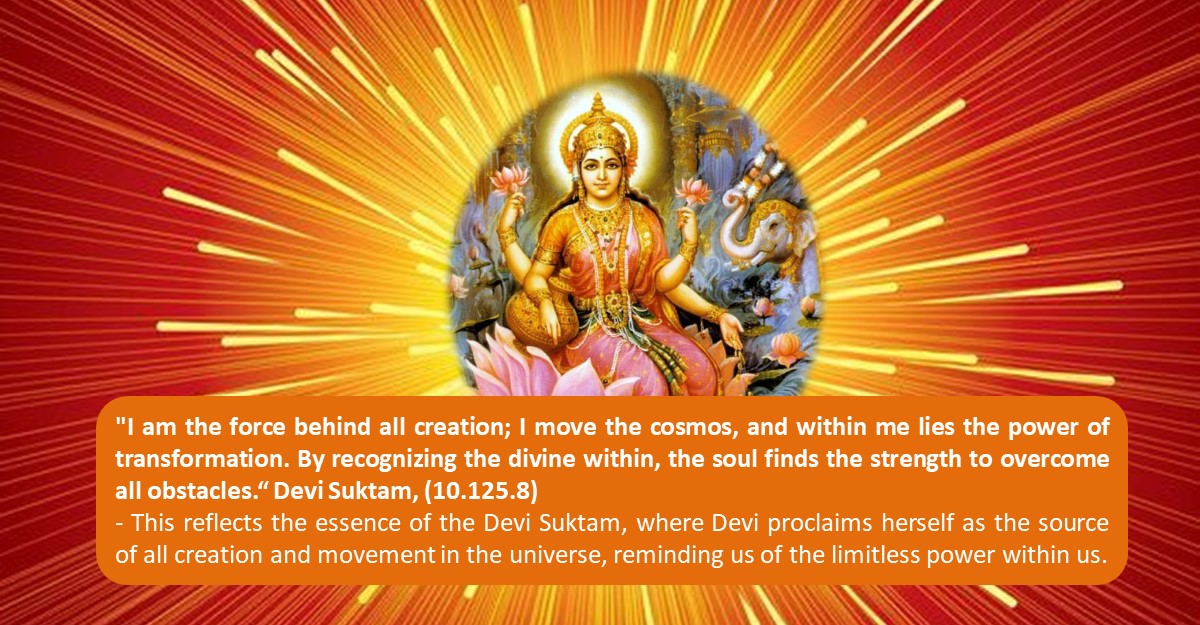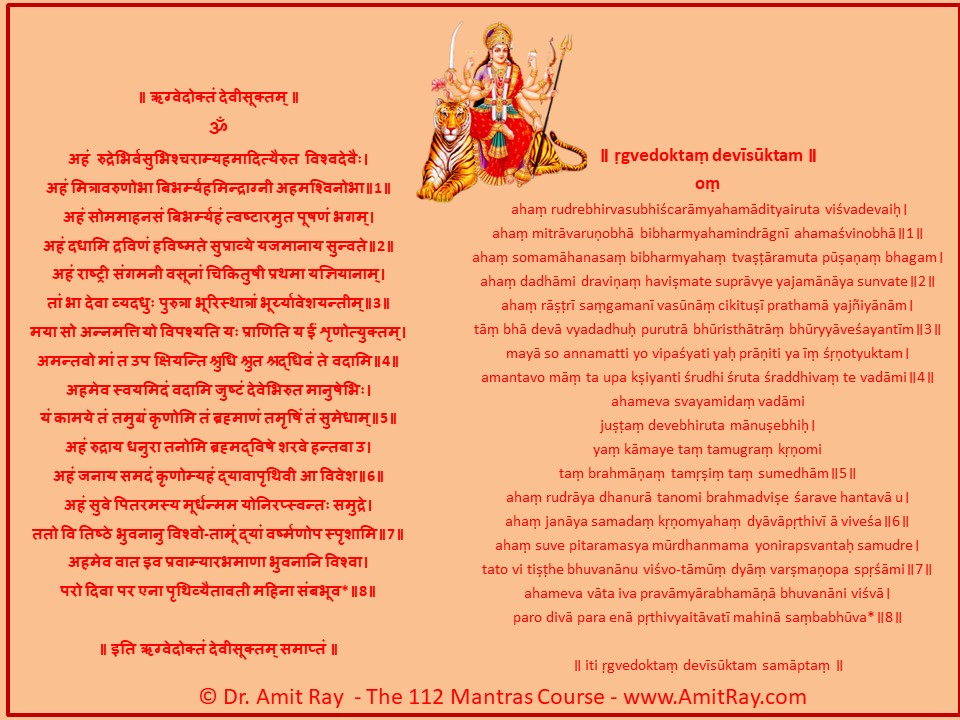Benefits | Meaning | Science | Lyrics
Purusha Suktam is an ancient hymn from the RigVeda dedicated to cosmic being, the deity of cosmic protection, nourishments, wealth, prosperity. The hymn remains a timeless expression of the Vedic worldview, blending cosmology, spirituality, and philosophy into a unified vision of existence. Its enduring relevance underscores its profound impact on Indian culture and philosophy.
"Purusha Suktam meditation reveals the eternal cosmic Self. The Purusha sees through every eye, speaks through every mouth, and walks with every foot. It dwells in everything and everyone. It is the essence of all existence." – Sri Amit Ray
This hymn is an essential part of Vedic literature, blending cosmology, spirituality, and metaphysics into a coherent narrative. It is often recited in various rituals to invoke the universal energy and to understand the interconnectedness of existence.

The Purusha Suktam is one of the Pancha Suktams (Five Sacred Hymns), which include the Purusha Suktam, Vishnu Suktam, Sri Suktam, Bhu Suktam, and Nila Suktam.
Puruṣa is the transcendental self or pure consciousness. It is absolute, independent, and free. However, the Bhagavata Purana and Mahabharata describe Vishnu as the ultimate Purusha (cosmic being) of the Purusha Sukta, symbolizing supreme divinity. The Shiva Purana, declares Shiva as the ultimate Purusha, representing the cosmic pure being and the source of creation. In Sri Vidya, Shakti manifests the cosmos, and Purusha remains the witnessing consciousness. Sri Vidya practices aim to harmonize these forces, leading to spiritual enlightenment and realization of the non-dual reality.
Purusha Suktam Sadhana
Purusha Suktam is an ancient prayer that invokes the wealth, bless with affluence, health, and the radiant inner joy. The Purusha Suktam Sadhana is a spiritual practice where devotees focus their energies on invoking the blessings of Lord Vishnu. This practice involves chanting, visualization, and concentration, all aimed at aligning oneself with the divine qualities of prosperity, generosity, and compassion.
Embrace Flexibility in Purusha Suktam Sadhana
Purusha Suktam Sadhana is about connecting with the cosmic Self, not following rigid rules. Too much rigidity and rules can block the flow of energy and awareness. Instead, keep your practice open and flexible. Trust the process and let it guide you naturally. Allow the mantras and meditation to unfold at your own pace, embracing your unique way of connecting with the Purusha.
"The true beauty of Vedic mantra chanting comes from the free flow of energy, not from rigidity. Open your heart, awaken your soul, and let the truth shine forth." - Sri Amit Ray
Mantra Chanting Style:
The chanting style of Purusha Suktam varies across different traditions. Traditionally, the first 15 mantras are chanted in Anushtup Chhanda, while the final verse is recited in Trishtup Chhanda. However, variations may exist depending on the specific tradition or lineage. For example, the way Purusha Suktam is chanted can differ in the Shiva, Shakti, and Vishnu traditions. These differences reflect the unique ways each one can connect with the cosmic energy through the chant.
For deep Sadhana, always chant in your own style. Find your rhythm and tune the vibration of your heart with the cosmic vibration in your unique way. The purpose of chanting Purusha Suktam is not merely to follow prescribed methods, but to harmonize your inner vibrations with the vast cosmic energy.
By chanting in your unique style, you align your heart’s vibration with the universal pulse. This personal connection allows the energy of the mantras to flow freely, creating a deep sense of peace and transcendence. Trust your intuition, feel the rhythm within you, and let your soul’s resonance blend with the cosmic sound. It is in this personal expression that the true power of Purusha Suktam is realized.
Here’s how practitioners can approach Purusha Suktam as a sadhana:
- Preparation:
- Begin by choosing a clean, quiet space and establishing a dedicated altar with a picture or idol of Lord Vishnu, and Goddess Lakshmi.
- Cleanse the area and yourself, ideally through bathing and wearing clean, comfortable clothing.
- Offer fresh flowers, incense, and a diya (oil lamp) to invoke the presence of Lord Vishnu.
- Recitation:
- Chant the Purusha Suktam with a focused, serene mind. Ideally, this recitation is performed during auspicious times, such as early morning or evening.
- Each verse can be repeated 3, 7, or 11 times, depending on one’s practice level and availability.
- While chanting, visualize divine cosmic radiant, benevolent presence surrounding you with his blessings.
- Mental Focus and Visualization:
- During the sadhana, visualize the cosmic divinity showering you with radiant light, symbolizing prosperity and joy.
- Feel an inner shift as qualities of generosity, love, and abundance permeate your being.
- Offering and Gratitude:
-
- Conclude the sadhana by offering gratitude to the Supreme Purusha. Offer food or sweets, which can later be shared as prasada.
The Purusha Suktam hymn is dedicated to Lord Vishnu, who is depicted as the cosmic Purusha, the ultimate being that transcends the universe. In the hymn, Vishnu, as Purusha, is portrayed as the source of all creation, encompassing both the material and spiritual worlds. The Purusha Suktam is composed in specific Chhandas (metrical forms), primarily using the Anushtup Chhanda for the first 15 mantras and the Tristup Chhanda for the final verse.
These metrical patterns are believed to generate a powerful spiritual energy, influencing the mind, body, and soul of the practitioner. This sacred combination of words and rhythms creates a resonance that aligns with cosmic forces, invoking blessings and protection from the divine.
Purusha Suktam Benefits
Chanting, listening to, or meditating on this hymn is believed to offer numerous spiritual, mental, and even physical benefits. Here are the primary benefits associated with the Purusha Suktam:
1. Spiritual Benefits
- Connection to the Divine: The hymn glorifies the universal cosmic form of Purusha, helping the devotee feel connected to the divine energy permeating the universe.
- Moksha (Liberation): Chanting the hymn is believed to aid in spiritual evolution, purify karma, and pave the way for liberation.
- Balancing Energy: It aligns individual consciousness with the cosmic consciousness, promoting harmony.
2. Mental and Emotional Benefits
- Inner Peace: Regular recitation helps calm the mind and reduce stress and anxiety.
- Focus and Clarity: The structured rhythm and profound meanings enhance concentration and mental clarity.
- Emotional Stability: It brings a sense of surrender and acceptance, fostering emotional resilience.
3. Material and Worldly Benefits
- Abundance and Prosperity: The hymn is often recited for blessings of wealth, health, and overall well-being.
- Success and Fulfillment: It removes obstacles and provides clarity for making righteous decisions, leading to success in endeavors.
4. Healing and Protective Benefits
- Purification: Chanting is said to cleanse the mind and environment, creating a positive and sacred atmosphere.
- Health Benefits: The vibrations generated during recitation have a soothing effect on the body and are believed to enhance vitality.
- Protection: It invokes divine protection and shields the devotee from negative energies.
5. Cosmic Understanding
- Understanding Oneness: The hymn emphasizes the interconnectedness of all existence, cultivating a sense of unity and compassion.
- Recognition of Universal Truths: It provides insights into the nature of creation, sustenance, and dissolution.
The Science of Purusha Suktam Chanting
The ancient sages recognized the vibrational power of sound and language, particularly Sanskrit, and employed this in the composition of sacred hymns like the Purusha Suktam. Here’s how modern science aligns with these ancient insights:
- Sound Vibration and Frequency: Sanskrit is known as a “vibrational” language, where each syllable carries specific energetic properties. The resonance created by chanting Sanskrit verses aligns the body's vibrations with universal energies, promoting harmony, calm, and focus. The 40 Hz mantra chanting of Purusha Suktam can be beneficial.
- Brainwave Entrainment: Chanting the Purusha Suktam in rhythmic patterns can influence brainwave frequencies, promoting a shift from higher beta waves (associated with active thinking) to alpha and theta waves (associated with relaxation and meditation). This brings about a meditative, calm state, essential for mental clarity and positive intentions.
- Impact on Chakras: There are 114 chakras in human body. Each verse of the Purusha Suktam addresses a specific energy or quality related to cosmic divinity, which can activate higher chakras. For instance, invoking cosmic unity may stimulate the infinity chakra and heart chakras, establishing a grounding presence and an open heart, which are essential for abundance.
- Effects on Heart and Breath Rate: Studies on chanting practices have shown that repetitive sounds slow the breathing and heart rate, promoting relaxation. The controlled breathing involved in chanting enhances oxygenation in the body and helps release stress hormones like cortisol, inducing a state of mental and emotional ease.
Purusha Suktam Meaning
Meaning for each of the Purusha Suktam slokas:
- Sloka 1: The Purusha, who has a thousand heads, eyes, and feet, pervades the entire universe and extends beyond it by ten fingers' breadth.
- Sloka 2: The Purusha is the essence of all beings and the future, transcending mortality, and he is the force by which the universe thrives.
- Sloka 3: The Purusha’s greatness is beyond measure; three-fourths of him are in the divine realm, and one-fourth remains in the earthly realm.
- Sloka 4: From his three divine aspects, the Purusha transcends the material world, and from his earthly aspect, he pervades the earthly existence.
- Sloka 5: From the Purusha’s body, the creation of the universe began, and the world expanded from him, with his body as the foundation.
- Sloka 6: Through the Purusha, the deities performed the yajna, offering clarified butter, with the seasons serving as the sacred offerings.
- Sloka 7: The deities and sages initiated the yajna by offering the Purusha to the sacred fire, completing the cosmic sacrifice.
- Sloka 8: From this sacrifice, all the animals, especially the horses, were created, symbolizing the essential elements of the universe.
- Sloka 9: From the yajna, the Vedic hymns, chants, and rituals emerged, with the sacred knowledge (Yajus) as a result of divine sacrifice.
- Sloka 10: The horses and cows were born from this cosmic sacrifice, signifying prosperity and the sustenance of life.
- Sloka 11: The Purusha's form was divided into different parts: his mouth became the Brahman (priest), his arms the Kshatriya (warrior), his thighs the Vaishya (merchant), and his feet the Shudra (worker).
- Sloka 12: The Brahman (priests) arose from his mouth, the Kshatriyas (warriors) from his arms, the Vaishyas (merchants) from his thighs, and the Shudras (laborers) from his feet.
- Sloka 13: The moon was born from his mind, the sun from his eyes, the fire from his mouth, and the wind from his breath.
- Sloka 14: The heavens arose from his head, the earth from his feet, the sky from his navel, and the directions from his ears.
- Sloka 15: The gods, through the sacrifice of the Purusha, made offerings into the fire, creating the universe as a whole.
- Sloka 16: Through the yajna, the gods obtained the path to higher realms, where they continue their divine work, just as the sages and ancestors once did.
Modern Science and Purusha Suktam
The Purusha Suktam of the Rigveda is a profound hymn that can be analyzed through the lens of modern scientific concepts in physics and cosmology. The hymn’s cosmological and metaphysical ideas resonate with contemporary scientific theories about the universe, its origin, and its fundamental interconnectedness.
Scientific Concepts Reflected in the Purusha Suktam
1. Unified Field Theory
- Description in the Suktam: The hymn describes the Purusha as a single, all-encompassing consciousness or entity from which everything in the universe emerges. The Purusha pervades all creation and transcends it, symbolizing unity in diversity.
- Scientific Parallels: Modern physics seeks a unified field theory, a framework that combines all fundamental forces (gravitational, electromagnetic, strong, and weak nuclear forces) into one underlying principle. Just as the Purusha is the singular source of all manifestations, the unified field represents the fundamental fabric of the cosmos, giving rise to all phenomena.
2. Cosmic Origin and the Big Bang
- Description in the Suktam: The creation of the universe is depicted as the result of a cosmic sacrifice, where the Purusha's body is disassembled to form the heavens, earth, stars, and living beings.
- Scientific Parallels: This mirrors the Big Bang Theory, where the universe originated from a singularity—a highly dense, infinitely small point—and expanded to create space, time, and matter. The hymn poetically captures this emergence of complexity from a single source.
3. Quantum Entanglement and Interconnectedness
- Description in the Suktam: The hymn emphasizes that all beings, natural elements, and the cosmos itself are interconnected as parts of the Purusha.
- Scientific Parallels: Quantum entanglement, where particles remain interconnected irrespective of distance, reflects this idea. Additionally, concepts in quantum mechanics propose that the universe functions as a singular, indivisible whole, akin to the Purusha’s omnipresence.
4. Multidimensional Reality
- Description in the Suktam: The Purusha is described as having “a thousand heads, a thousand eyes, and a thousand feet,” existing beyond the perceptible universe and transcending physical dimensions.
- Scientific Parallels: String theory and M-theory in modern physics postulate that the universe exists in multiple dimensions beyond the four-dimensional spacetime we perceive. These higher dimensions may be the substrate for the unity described in the hymn.
5. Cosmic Cycles
- Description in the Suktam: The sacrifice and regeneration of the Purusha hint at a cyclical process of creation, destruction, and re-creation, resonating with the idea of cosmic order (Rta).
- Scientific Parallels: Cosmology explores cyclic universe theories, such as the Big Bang followed by a Big Crunch or a Big Bounce, where the universe undergoes perpetual cycles of creation and collapse.
6. Observer’s Inclination, Spacetime, and Purusha
- Spacetime as a Unified Field: In general relativity, spacetime is a flexible, dynamic entity that responds to the presence of mass and energy. Similarly, the Purusha Suktam envisions a unified consciousness that governs all existence, a cosmic force that is ever-present, even beyond the observable universe. The bending of spacetime around black holes can be seen as a physical analogy to the presence of the Purusha, which transcends and influences all aspects of reality, from the material world to the metaphysical.
- Observer’s Role: Just as the observer's position and perspective impact the interpretation of photon rings in modern physics, the Purusha Suktam also suggests that human perception is only a small part of a larger, infinite cosmic order. The hymn teaches that the Purusha, though present in all things, can be understood in different ways depending on the observer’s level of awareness or spiritual inclination. This idea resonates with the observer effect in physics, where an observer influences the outcome of what is being observed, be it in the context of light around a black hole or the understanding of cosmic consciousness.
- The complex nature of photon rings, dependent on the observer’s inclination [2] and spacetime curvature, mirrors the Purusha Suktam's depiction of the cosmic being that appears differently depending on one's spiritual perspective and understanding.
Philosophy and Consciousness
The hymn’s assertion that the Purusha is both immanent and transcendent parallels modern discussions on the role of consciousness in physics:
- Panpsychism: This theory posits that consciousness is a fundamental feature of the universe, much like the all-pervasive Purusha.
- Participatory Universe: Proposed by physicist John Wheeler, it suggests that observers (conscious beings) play a role in shaping reality, echoing the Purusha’s active role in manifesting the cosmos.
Energy, Matter, and Consciousness Interplay
- Description in the Suktam: The Purusha transforms into all material and immaterial elements of the universe.
- Scientific Parallels: Einstein’s equations illustrate how energy and matter are interchangeable, reinforcing the idea of a unified source for all diversity.
- Consciousness as Observer: Just as an observer can collapse quantum states (Chalmers), consciousness, according to the Purusha Suktam, shapes the very fabric of reality.
Why This is Significant
The Purusha Suktam bridges ancient spiritual wisdom and modern scientific inquiry, demonstrating:
- Timeless Universality: The Vedic seers intuited concepts that resonate with cutting-edge science.
- Integration of Science and Spirituality: The hymn emphasizes the interconnectedness of existence, encouraging a holistic view that unites physical phenomena with consciousness.
- Inspiration for Exploration: Its poetic description of cosmic origins inspires philosophical and scientific exploration of the universe’s mysteries.
The Purusha Suktam is not merely a religious hymn but also a profound cosmological text that reflects humanity's perennial quest to understand the universe. Its parallels with modern scientific ideas underscore its timeless relevance, offering a synthesis of metaphysical and scientific thought.
Key Verses and Their Meanings
- “Sahasra-Shirsha Purusha”
- Meaning: Purusha is described as having infinite heads and eyes, symbolizing his omnipresence.
- Significance: This verse highlights that Purusha is not confined by time or space but is the foundation of all existence.
- Creation from the Cosmic Being
- The sun, moon, stars, and earth emerge from Purusha, illustrating how everything tangible and intangible stems from a singular source.
- The Sacrifice
-
- Through the metaphor of a cosmic sacrifice, the hymn explains that the universe and its laws are maintained through balance and transformation.
Origins and Extensions: Key Variations in Style and Content
- Meter and Structure: The Rig Vedic text is mostly in the Trishtubh and Anushtubh meters, while adaptations in the Yajurveda and Atharvaveda may adjust meter for liturgical compatibility.
- Focus of Interpretation:
- The Rig Veda emphasizes universal philosophy.
- The Yajurveda integrates it into the ritual framework.
- The Atharvaveda adopts it for practical, mystical purposes.

Importance
- Cosmological Perspective:
The hymn explains the origin of the universe and its components, aligning metaphysical concepts with natural phenomena. - Spiritual and Theological Significance:
It introduces core ideas of Vedic thought, such as sacrifice (yajna) as a fundamental process of creation and sustenance. It is also a foundation for later theological systems like Vedanta. - Philosophical Depth:
It serves as a precursor to Upanishadic thought, delving into the nature of the divine, the universe, and the self. - Ritual and Devotion:
The Sukta is integral to several Vedic rituals and is recited in prayers, yajnas, and other ceremonies, particularly in Vaishnavism, where it is associated with Vishnu's divine form.
Significance of Purusha Suktam
The Purusha Suktam is one of the most revered hymns from the Rigveda (Mandala 10, Sukta 90). It narrates the creation of the universe from the primordial cosmic being, Purusha, and is considered to be foundational in both Vedic cosmology and spirituality. This hymn is widely studied not only for its theological implications but also for its reflection of the deep metaphysical understanding of the universe. The Purusha Suktam holds significance on multiple levels:
Spiritual and Cosmic Unity:
At its core, the Purusha Suktam reflects the unity of the cosmos, portraying the universe as emerging from a singular divine entity. The Purusha’s body is said to be the source of all creation, embodying the idea of a non-dual reality, where all manifestations are interconnected and emerge from one source. This mirrors modern ideas in quantum physics and cosmology, where the universe is often described as interconnected at a fundamental level [1].
Cosmic Creation and Sacrifice:
The hymn presents creation as a sacrifice—the Purusha, in his divine essence, offers himself in a cosmic yajna (ritual sacrifice) from which the universe and all life forms are born. This theme of cosmic sacrifice can be compared to the Big Bang Theory, where the universe’s beginning is marked by a singular event that triggered the expansion of space and matter. The idea of sacrifice as a means of creation aligns with ancient views that the universe operates through selfless exchanges of energy.
Philosophical and Theological Significance:
The Purusha Suktam provides insights into the Vedic philosophy of Vedanta, where the Purusha represents the ultimate, formless reality from which all dualities, such as the material and the spiritual, arise. The hymn suggests that the physical world is an expression of the divine essence, leading to a pantheistic understanding of the universe where God is both immanent and transcendent. This resonates with contemporary spiritual thought, especially in Advaita Vedanta, which sees Brahman as the singular truth underlying all existence. The Purusha Suktam emphasizes the importance of dharma (righteousness) and interdependence in creating a harmonious society. Interdependence, bonding and support are deeply associated with improving mental wellbeing [3].
Psychological Transformation and Inner Harmony:
On a psychological level, reciting the Purusha Suktam is believed to bring about a transformation in the individual’s mindset, shifting focus from personal desires to universal consciousness. The hymn encourages self-reflection, aligning one’s actions with the cosmic order and embracing virtues such as selflessness, wisdom, and compassion.
Symbolic Imagery:
The Purusha Suktam uses powerful imagery, such as the thousand heads, thousand eyes, and thousand feet of the Purusha, to represent his omnipresence and the infinite nature of the divine. These descriptions mirror modern theories in string theory and quantum mechanics, which propose that the universe, at its deepest level, is interconnected and operates as a unified whole.
Spiritual and Ritualistic Importance:
The Purusha Suktam is not just a philosophical treatise; it is also a central part of Vedic rituals. It is recited during various yajnas and spiritual ceremonies to invoke divine blessings for prosperity, health, and spiritual growth. Its recitation is believed to bring cosmic order and alignment with the universal consciousness, a practice that has been carried on for thousands of years.
The Purusha Suktam is much more than a hymn; it is a profound philosophical text that integrates cosmology, spirituality, and social ethics. Its teachings continue to influence various traditions and modern philosophical and scientific thought, providing a bridge between ancient wisdom and contemporary discoveries in the fields of quantum physics and cosmology. Through its timeless message of unity, creation, and harmony, the Purusha Suktam remains a cornerstone of Vedic spirituality and continues to inspire seekers across the world.
FAQ
Q1. Can we chant Purusha Suktam daily?
Yes, you can absolutely chant the Purusha Suktam daily! In fact, daily chanting of the Purusha Suktam is beneficial for attracting and sustaining prosperity, peace, and well-being in their lives. Here's why and how daily chanting can be advantageous:
Benefits of Daily Chanting
- Enhanced Prosperity and Abundance: Regularly chanting the Purusha Suktam invokes Lord Vishnu, and Goddess Lakshmi’s blessings, drawing both material and spiritual prosperity. It helps establish an “abundance mindset,” fostering gratitude and positive energy.
- Mental Clarity and Positivity: The rhythm and sound vibrations of the Purusha Suktam bring a sense of mental peace and positivity. Daily recitation aligns the mind with uplifting qualities like generosity, compassion, and joy.
- Purification of Space and Aura: The vibrational quality of Sanskrit verses purifies the space where it’s chanted, creating a calm and serene environment. It also strengthens the aura, offering protection against negative energies.
- Spiritual Growth: Regular chanting aids in aligning one’s intentions with higher, selfless goals, encouraging inner growth and detachment from material worries.
Best Times to Chant
- Early Morning (Brahma Muhurta): This is traditionally the best time for any spiritual practice, as the mind is calm and receptive.
- Evening (Sunset or After Sunset): Chanting at sunset is also beneficial, as it invokes a sense of gratitude and prepares the mind for relaxation.
Simple Steps for Daily Purusha Suktam Chanting
- Set Up a Peaceful Space: Dedicate a clean, quiet space for your chanting. You may place a picture or idol of Goddess Lakshmi, light a lamp or incense, and offer flowers if possible.
- Prepare Yourself: Wash your hands and face to enter a state of physical cleanliness. Sit comfortably in a stable posture, with your spine upright.
- Chant Slowly with Focus: Begin chanting each verse of the Purusha Suktam with focus and intention. If possible, chant it three times for a fuller impact, visualizing Lord Vishnu’s presence and blessings.
- Express Gratitude: Conclude by offering gratitude to Lord Vishnu, acknowledging the blessings of prosperity, health, and peace.
Special Considerations
- Clarity in Pronunciation: Since the Purusha Suktam is in Sanskrit, correct pronunciation is essential to harness the full power of the mantra. Learning from a teacher or listening to guided recitations can be helpful.
- Intention and Consistency: Consistent daily practice is more impactful than occasional chanting. Your positive intention and sincere devotion amplify the effects of the chant.
Daily Purusha Suktam chanting can be a powerful practice that enhances prosperity, mental clarity, and spiritual growth, bringing joy and fulfillment into daily life.
Q2. What is the Protocol for Reciting Purusha Suktam
Purusha Suktam is an ancient hymn from the RigVeda dedicated to cosmic being, the deity of cosmic protection, nourishments, wealth, prosperity, and abundance. It is considered one of the most auspicious chants for invoking the blessings of prosperity, inner radiance, and positive energy. The hymn describes the qualities of Cosmic Being and his various forms of blessings, making it highly revered in Hindu traditions, particularly for attracting both material and spiritual prosperity.
Protocol for Reciting Purusha Suktam
- Cleanse the Space and Yourself:
- Before reciting, it’s beneficial to clean the chanting area to invite positive vibrations.
- Personal cleanliness, such as washing hands and face or even bathing, if possible, helps in preparing oneself mentally and physically for the chanting.
- Create a Peaceful Setup:
- You can place an image or idol of Lord Vishnu, and Goddess Lakshmi if you have one.
- Light a lamp (preferably with sesame oil or ghee) and, if desired, incense sticks to enhance the atmosphere.
- Select the Best Times for Chanting:
- Brahma Muhurta generally begins 96 minutes before sunrise and remains for 48 minutes. Brahma Muhurta typically lasts for 1 muhurta, which is 48 minutes, beginning 96 minutes before sunrise. Assuming sunrise is at 6:00 AM: Brahma Muhurta would be from 4:24 AM to 6:00 AM. This early morning around is considered ideal, as the mind is quiet and focused.
- Alternatively, chanting in the evening, especially around sunset, is also auspicious and believed to attract the blessings of peace and abundance.
- Pradosha Kalam is the period of 2 hours and 24 minutes after sunset on a given day. It is considered the most auspicious time for worshipping Lord Shiva, Lord Vishnu, and Goddess Lakshmi. Pradosh Kaal begins after sunset and lasts for 3 muhurtas, which is approximately 144 minutes.
- Posture and Concentration:
- Sit in a comfortable, steady posture with the spine upright, ideally in a meditative cross-legged position, or on a chair if needed.
- Maintain a calm and focused mind throughout the chant, visualizing the Lord Vishnu, and invoking his presence.
- Begin with a Prayer or Dedication:
- Start with a simple prayer to seek blessings from Lord Vishnu, and Goddess Lakshmi and purify the surroundings. If you want, you may chant an initial invocation mantras.
- Chant Slowly and Clearly:
- Recite each verse slowly with proper pronunciation and clarity. Since Sanskrit words carry specific vibrational qualities, correct pronunciation enhances the effects of the chant.
- If learning the pronunciation, you may want to listen to a recorded recitation by a knowledgeable source.
- Repetitions (Optional):
- Traditionally, Purusha Suktam can be chanted once, three times, or more, based on personal preference and the desired effect. Three times is common for daily practice, while more repetitions can be done on Fridays or during special prayers.
- Conclude with Gratitude:
- End the session with gratitude, either by offering flowers, fruits, or a simple acknowledgment to Lord Vishnu his blessings and presence.
- Meditate or Reflect Post-Chanting:
-
- Spend a few moments in silence to absorb the energy of the chant and to meditate on the qualities of abundance, peace, and gratitude. This helps integrate the effects of the chant into your day.
Q3. At exactly what time does Brahma Muhurta start and end every day?
Brahma Muhurta begins 1 hour and 36 minutes (approximately 96 minutes) before sunrise and ends 48 minutes before sunrise each day. The day is divided into 15 muhurtas and the night into another 15 muhurtas. Brahma Muhurta is the 14th muhurta of the night.
Here’s how it works:
- Start Time: Brahma Muhurta starts 96 minutes before the actual sunrise time at your place.
- End Time: It ends 48 minutes before sunrise.
The exact time for Brahma Muhurta changes daily depending on the local sunrise time for your location. For example, if sunrise is at 6:00 AM:
- Brahma Muhurta Start Time: 4:24 AM
- Brahma Muhurta End Time: 5:12 AM
Additional Tips
- Thursday Practice: Thursday, known as Lord Vishnu, and Goddess Lakshmi's day, are especially auspicious for Purusha Suktam chanting.
- Moon Days: Chanting Purusha Suktam on full or new moon days is also said to be powerful for manifesting abundance.
- Intention and Devotion: More than the exact protocols, sincere intention and devotion bring about the true benefits of the chant.
Through the Purusha Suktam, practitioners connect deeply with divine energies that nurture material well-being, spiritual growth, and a sense of peace, making it a timeless practice of abundance.
Conclusion
The Purusha Suktam is more than a mere invocation; it is an ancient expression of humanity's desire for a balanced, fulfilling life. Through its hymns, the Purusha Suktam draws the devotee into a world where divine beauty, compassion, and abundance are possible and accessible. As we chant or reflect on this hymn, we invite not only wealth but also harmony, gratitude, and a life aligned with the universal energies of prosperity
Read more ..

